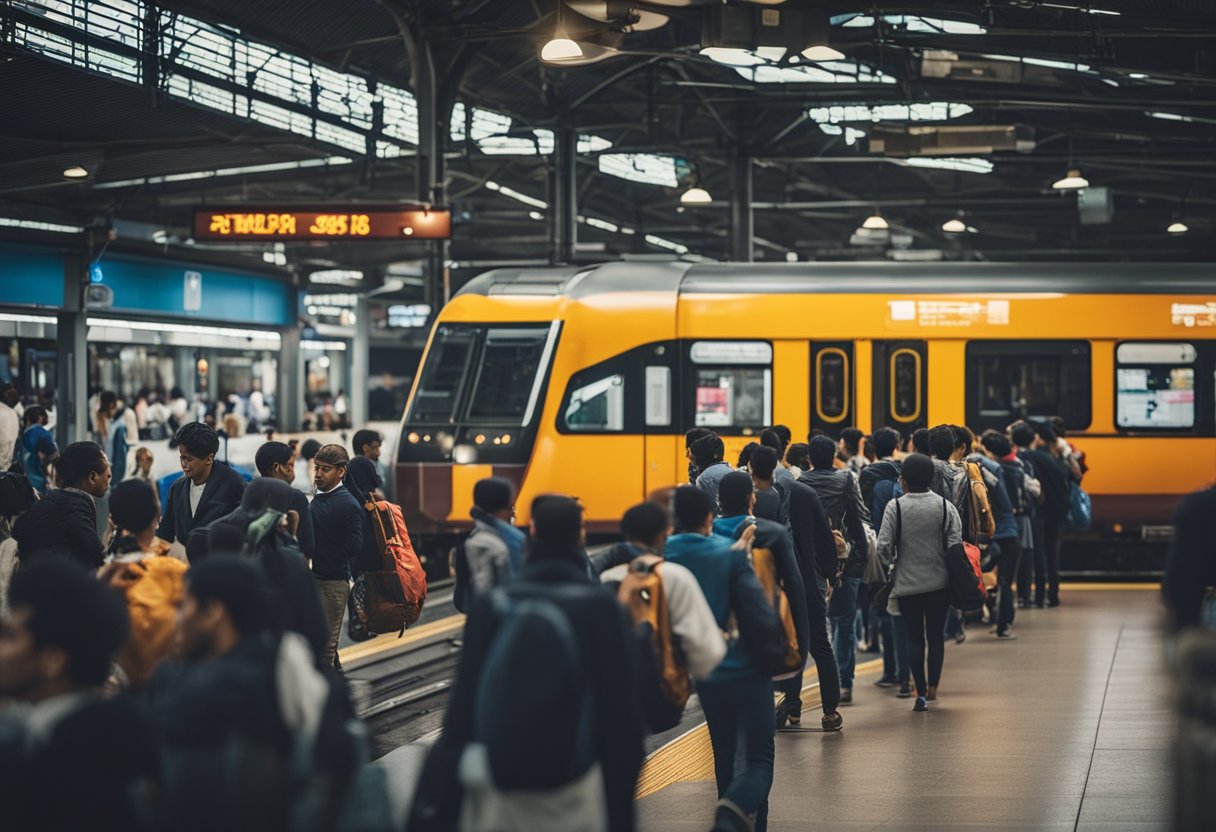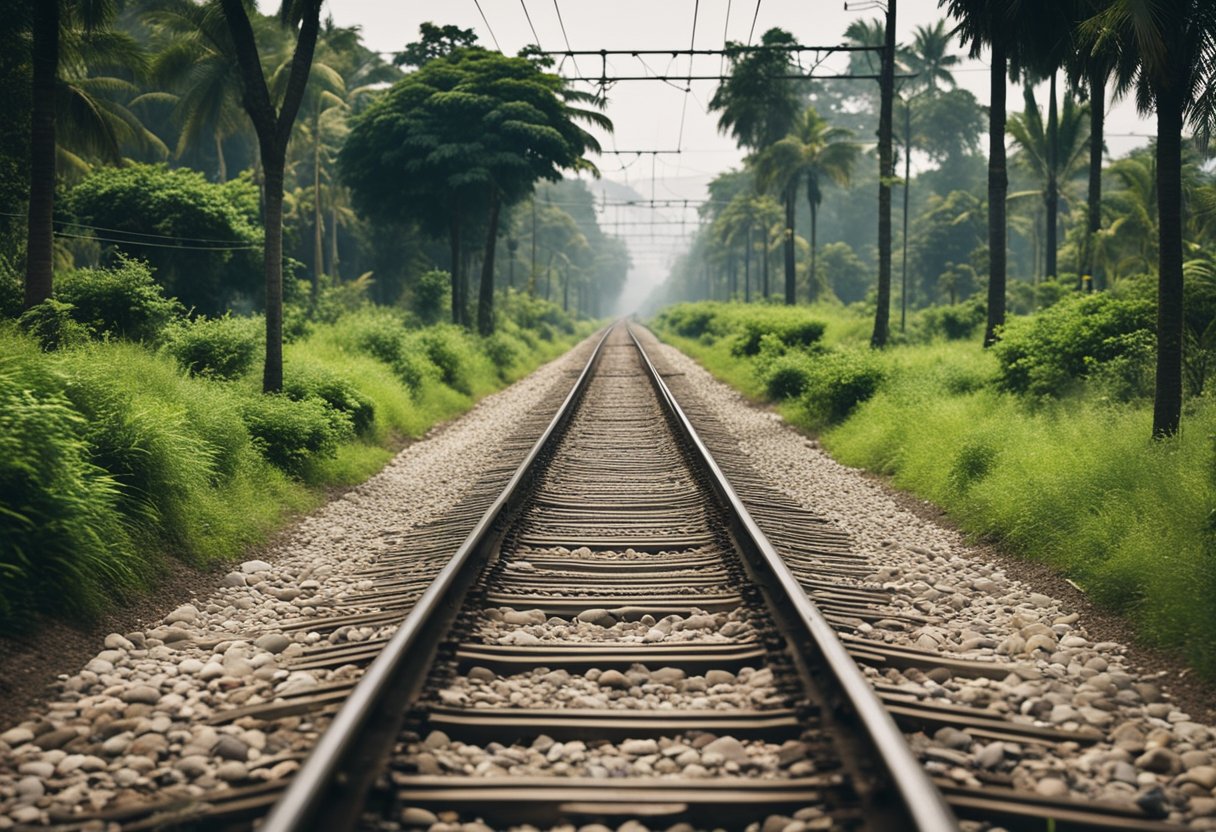The Railways of India: Lifelines of a Nation – An Insight into Their Pivotal Role

Updated On: April 13, 2024 by Maha Yassin
The Railways in India are the backbone of its development and an emblem of its progress over the years. With origins dating back to the British colonial era, the Indian Railways has grown into one of the world’s largest and busiest rail networks, deeply ingrained into the nation’s fabric. Serving as the lifeline of India, it connects remote villages to bustling cities, facilitating not only the movement of people but also propelling the economy forward by transporting many goods nationwide.
We observe that the dynamic growth of Indian Railways is a testimony to the country’s commitment to progress and innovation. The railway network has significantly enhanced passenger experience through constant modernisation and expansion, ensuring improved safety and security measures. It has played a pivotal role in connecting various regions, thus promoting national integration. The intricate railway system vividly illustrates how a single industry can catalyse comprehensive societal and economic transformation.
History and Evolution of Indian Railways
The story of Indian Railways is an epic journey connecting diverse cultures and economies across one of Asia’s greatest landscapes. We will explore how this pivotal network became the lifeline it is today, charting progress from its inception to modern times.
From Inception to Independence
The foundations of Indian Railways were laid in 1853 when the first train steamed from Mumbai to Thane. This historical event marked the beginning of a rail system that would become crucial to India’s development. Through an alliance between the Great Indian Peninsular Railway (GIPR) and the East India Company, a rich history of collaboration and engineering brilliance unfolded. The railway expansions throughout Eastern and Southern India in the subsequent years connected remote regions, fostering trade and enabling the mobility of millions.
By the end of the 19th century, Indian Railways had become a vast network. However, it was not just a commercial enterprise but a symbol of unity in a land of immense cultural diversity. It played a pivotal role in social integration and became integral to India’s struggle for independence. The railways transported goods and people and ideals and aspirations from one corner of the nation to another.
Post-Independence Progress
In the aftermath of independence in 1947, Indian Railways inherited a disjointed network that required unification and modernization. The formation of the Indian Railway Board symbolized the transition to a single system. As we entered a new era, the focus shifted towards improving efficiency, increasing connectivity, and facilitating economic growth. Passenger services were expanded, and freight operations were optimized to support India’s burgeoning economy.
With technological advancements, Indian Railways embarked on a path of continual improvement. Electrification of tracks, introducing high-speed trains, and upgrading safety measures became hallmarks of India’s quest for a modern railway infrastructure. India’s daunting topography and societal needs dictated innovative solutions, such as the mountain railways, which showcased engineering prowess and became part of the unique charm that the Indian Railway system is known for.
Throughout these changes, Indian Railways has remained the nation’s backbone, carrying over 8 billion passengers annually and standing as a testament to India’s ability to merge its rich cultural tapestries with the demands of its dynamic economy. This evolution from colonial times to a modern-day powerhouse exemplifies how deeply the railways are entrenched in the lifeblood of India’s identity and progress.
The Indian Railway Network
Indian Railways stands as one of the fastest and most intricate railway networks in the world, playing a pivotal role in the movement of people and the economy.
Extent and Connectivity
Our network acts as the bedrock of transportation infrastructure, connecting the furthest corners of the country. From the snow-capped peaks of the Himalayas to the tropical landscapes of the south, the railways link many cities, towns, and villages. This labyrinth of routes facilitates economic growth by supporting trade and commerce and uniting culturally and geographically diverse populations.
Track and Route Length
The track length of the railway extends over 67,000 kilometres, making it one of the largest railway networks in the world. These tracks encompass numerous route lengths, some renowned for their engineering marvels, such as traversing mountainous terrains or bridging vast rivers. The infrastructure is continuously being upgraded and expanded to meet the nation’s growing demands and enhance connectivity across regions.
Indian Railways Passenger Services

We cater to a myriad of travel needs through our passenger services. Indian Railways operates a comprehensive network offering daily commuting options and long-distance travel conveniences, facilitating the routine transit of passengers and their spiritual and leisure journeys.
Daily Commute and Long-Distance Travel
Daily, we provide an extensive range of suburban services tailored to commuters, ensuring millions can easily reach their workplaces. These trains are the lifelines for passengers travelling within metropolitan areas and their suburbs. For those embarking on longer journeys, our long-distance passenger trains offer a range of options, from affordable sleeper classes to more comfortable air-conditioned tiers, making intercity travel accessible and reliable.
Pilgrimage and Sightseeing Trains
We understand the importance of India’s rich cultural and spiritual heritage. Special trains cater to the needs of those undertaking pilgrimages, connecting major religious sites nationwide. For travellers keen on exploring India’s scenic beauty and historical landmarks, sightseeing trains traverse routes specifically chosen to showcase the splendours of the nation, offering an enriching experience beyond mere transit.
Freight and Logistics
Exploring the vast network of Indian Railways, we find that freight and logistics are critical to sustaining the country’s economy. The railways facilitate the movement of essential commodities and are vital in the nation’s supply chain.
Freight Transport Infrastructure
Indian Railways operates one of the largest rail networks in the world, tailored for both passenger and freight transportation services. The dedicated freight corridors are a game-changer, streamlining the transport of goods across vast distances. Notably, the Eastern and Western freight corridors are significant developments enhancing the efficiency of freight trains. These corridors allow for faster and more reliable freight movement, diminishing the transit time and increasing the rail share in transporting goods.
Freight trains are equipped to handle diverse commodities, from mineral ores to agricultural products, playing a pivotal role in the national economy. By transporting large volumes over long distances, these freight services provide a cost-effective and environmentally friendly alternative to road transport.
Commodities and Freight Loading
The Indian Railways’ network is integral to the movement of commodities such as coal, iron ore, cement, food grains, and fertilisers. The loading of such commodities is meticulously managed to maximise efficiency and meet the ever-increasing demands of the country’s economy.
Coal remains the predominant commodity transported, catering to the power plants that fuel the nation’s energy requirements. Mineral ores such as iron and steel necessitate efficient handling due to their weight and volume. For these commodities, specialised wagons are utilised to provide ample capacity and secure transportation.
To sum up, the freight loading systems of Indian Railways are designed to be robust and scalable, meeting the logistical demands of a diverse range of industries. The country is poised to bolster the railway’s share in the overall transportation sector through targeted policies and infrastructure enhancement, ensuring a sustainable future for freight movement in India.
Economic Impact of The Railways of India
The Railways of India serve as a pivotal mode of transport and significantly impact our nation’s economy. They are the backbone of trade and have a monumental role in the country’s socio-economic development.
Contribution to GDP and Employment
The Indian Railways are a critical national asset contributing substantially to the country’s Gross Domestic Product (GDP). It is among India’s largest employers, providing jobs directly and indirectly to millions of individuals. This extensive network supports industries, from manufacturing to services, fuelling the nation’s economic machinery. Moreover, revenues generated are pivotal, with the sector earning significant gross revenue that feeds back into the country’s budget. This income sustains the railway system and bolsters the broader business landscape, aiding urban and rural areas.
Railways and Economic Development
As a driver of comprehensive economic development, the railways have historically been instrumental in connecting business markets and fostering trade and commerce across the vast expanse of the country. Policies focusing on investment in railway infrastructure signal the government’s commitment to enhancing this network. Recently, initiatives have been undertaken to attract foreign direct investment (FDI) to upgrade freight services and develop high-speed corridors, further leveraging the railways’ capacity to bolster India’s economy. The expansion and modernisation of the railways are essential to meet the growing demands of the country’s economy and maintain its growth trajectory.
Modernisation and Innovation
In the quest to enhance operations and safety, we witness the Indian Railways embracing state-of-the-art technologies. Our efforts in modernisation and innovation are geared towards bolstering efficiency, propelling the nation’s growth and keeping pace with global benchmarks.
Technological Advancements in Operations
We have observed remarkable strides in operational technology within Indian Railways. Strategies like the induction of high-horsepower electric locomotives significantly reduce reliance on diesel, aligning with eco-friendly objectives. Additionally, computerisation has streamlined ticketing to freight management, ushering in an era of better customer service and operational fluency.
Infrastructure and Modern Signalling Systems
Our infrastructure now showcases state-of-the-art signalling systems, which are pivotal for safety and enhancing line capacity. The ongoing upgrades in our signalling design include aspects like automatic train control and advanced traffic management systems. Such innovation amplifies efficiency and plays a crucial role in minimising the chances of untoward incidents on the extensive rail network.
Safety and Security
In addressing the critical aspect of safety and security, we must spotlight the robust measures for passenger safety and the technological advancements enhancing freight safety in India’s vast railway network. Our railways, a vital artery for people and goods, implement dynamic strategies to ensure secure and reliable travel.
Measures for Passenger Safety
Comprehensive Safety Protocols: We have established stringent safety checks and routine maintenance protocols for our trains and infrastructure, reducing the potential for accidents and ensuring a high standard of passenger security. For instance, regular inspections of bridges and timely repairs are conducted to fortify the structural integrity of rail networks.
Innovative Solutions for Challenges: Addressing pedestrian safety, Indian Railways has championed the elimination of all unmanned level crossings on Broad Gauge routes, a significant step towards mitigating risks of accidents. Initiatives have also been launched to raise public awareness about the importance of adhering to safety guidelines around railway premises.
Advancements in Freight Safety
State-of-the-Art Monitoring Systems: We are advancing freight safety by implementing cutting-edge technologies like GPS-based tracking systems, which allow for real-time monitoring of freight movements and swift response in case of any irregularities.
Enhanced Infrastructure for Freight Transport: Indian Railways has taken strategic measures to upgrade the infrastructure catering to freight services, thus strengthening the safety of goods in transit. These efforts include the development of dedicated freight corridors designed to facilitate smooth and secure cargo movement across the country, echoing Indian Railways’ commitment to safety.
Challenges and Future Outlook

In navigating the complexities of its vast network, the Indian Railways must confront pertinent challenges and chart a course for progressive growth. The future outlook hinges on addressing existing limitations while setting proactive targets.
Addressing Capacity Constraints and Under-Investment
The Indian Railways grapples with capacity constraints that result from years of under-investment. Ensuring the completion of projects like the Dedicated Freight Corridors is critical to easing the current pressure on the network. Enhancements in tracks, signalling systems, and rolling stock are imperative to expand operational capacity.
Setting Targets and Priorities for Growth
Our priorities are oriented around strategic growth, underpinned by clear and achievable targets. Enhancements in safety, adopting green technologies, and pursuing network electrification form the core of our growth strategy. The focus is also on embracing digital technologies to bolster efficiency and improve passenger experiences. With specific targets such as the expansion of suburban networks and the establishment of high-speed rail, as detailed in analyses, we are paving the way for a transformative era for Indian Railways.
The Role of Indian Railways in Connectivity
The Indian Railways is a fundamental part of the nation’s transportation infrastructure, exemplifying the ethos of connecting diverse regions and fostering unity through mobility. We examine how this vast network sets the foundation for uniform development and integration across India.
Linking Rural and Urban Centres
With tracks stretching across the subcontinent, we see the Indian Railways as the crucial link between rural areas and urban centres. This vast network ensures that even the most remote villages have a pathway to the bustling cities. Rural inhabitants gain access to wider markets, healthcare, and education, allowing them to participate in the broader economic and social milieu.
Strengthening the National Transport Network
By its massive expanse and consistent service, the railways form the backbone of our national transport network. The provision of reliable routes for freight and passenger transit aids in the seamless flow of commerce and movement of people. This intricate network supports the nation’s growth and plays a pivotal role in knitting together the fabric of our diverse country through enhanced connectivity.
Railways and Indian Society
The Indian Railways mobilise millions of people and goods across the states and serve as a key employer and a symbol of unity post-independence. While bolstering movements of goods crucial for agriculture and other sectors, they knit together the diverse fabric of the nation.
Employment Opportunities and Staff Welfare
As one of the largest employers in India, the railways provide substantial employment opportunities to our nation’s citizens. Our railway system supports over 1.2 million employees, reflecting the dedication to staff welfare and economic stability. Employment in the Indian Railways is highly sought after, providing various roles from technical staff to administrative positions. We support our staff through training, benefits, and a caring work environment. This commitment extends to creating policies aimed at improving the livelihoods of our employees and their families.
The Railways as a Symbol of National Unity
Since our independence, the railways have become a powerful national unity symbol. This vast network links remote corners of India to bustling urban centres, underscoring a sense of belonging amongst disparate states. Our trains traverse the length and breadth of the country, carrying not just people but the collective aspirations of Indians. The railways catalyse the movement of goods essential for agriculture and other industries, thereby unifying the country’s economic objectives with its social fabric. This convergence has been vital to our national narrative and continues to spark collective pride in our achievements.
The Indian Railways encapsulate the spirit of India, powering movements, supporting employment, nurturing staff, and symbolising our united march towards progress.
Conclusion
In summarising our journey through the exploration of Indian Railways, we must acknowledge its foundational role in the socio-economic framework of our nation. The railways have not only been pivotal in stitching together the geographical diversity of India but also provided an economic thrust, propelling the nation towards development.
Economic Impact: Our railways have catalysed commercial growth, facilitating trade across the length and breadth of the country. The vital link they provide between urban and rural areas has been instrumental in inclusive economic progress.
Social Unity: The train journeys are a melting pot of cultures, directly reflecting our ethos of unity in diversity. Every carriage narrates a story of India, bringing together people from various walks of life.
Future Outlook: The focus is shifting towards modernisation and infrastructure enhancement. The aim is to increase safety, punctuality, and speed, improving the overall passenger experience. We are steadfast in pursuing advancements that will ensure our railways remain the lifeline of our nation.
Commitment to Sustainability: As we embark on this journey, we remain committed to sustainable practices, recognising the importance of preserving our environment while nurturing growth. Our vision aligns with platforms like Connolly Cove, acknowledging the delicate balance between progress and conservation.
The conclusion that unfolds is thus not an end but a forward-looking statement of progress woven into our nation’s development narrative. As we continue to embrace changes, the Indian Railways will invariably hold a mirror to the evolving face of India, reflecting resilience, adaptation, and the relentless spirit of moving forward together.
FAQs
In addressing the frequent queries related to the railways, we uncover their integral role in our nation’s economic and infrastructural vitality.
What role do railways play in India’s economic growth?
Railways in India form a cornerstone of the economy, underpinning the movement of goods and passengers across the country. They are instrumental in enabling trade and unlocking regional markets, contributing to economic expansion.
How have Indian Railways contributed to national development?
Indian Railways have been pivotal in fostering national integration and enabling development to reach remote areas. They have facilitated the dissemination of cultures, ideas, and resources, driving nationwide progress.
In what ways are railways considered the lifelines of the Indian economy?
The expansive railway network is often termed the lifeline of the Indian economy due to its role in connecting various production and consumption centres. It supports various economic activities by ensuring the reliable transport of commodities, which sustains businesses and industries.
What are the primary slogans associated with Indian Railways, and what are their significance?
The slogans like “Indian Railways – Lifeline of the Nation” encapsulate the essence of the railways’ vital role in everyday lives and the nation’s functioning. They highlight the extensive reach and profound impact of the railway system on the collective progress of India.
Why is railway transportation crucial for India’s infrastructure?
Railway transportation is the backbone of India’s infrastructure, facilitating large-scale movement while being cost-effective and energy-efficient. This mode of transport plays a key role in connecting urban and rural areas, enhancing accessibility and spurring infrastructural growth.
How does the railway network support the livelihoods of Indian citizens?
The railway network supports livelihoods by generating direct and indirect employment opportunities and providing a means for millions to access markets, education, and healthcare. It’s a reliable channel for the mobility of the workforce, which undergirds the economy and social welfare.






